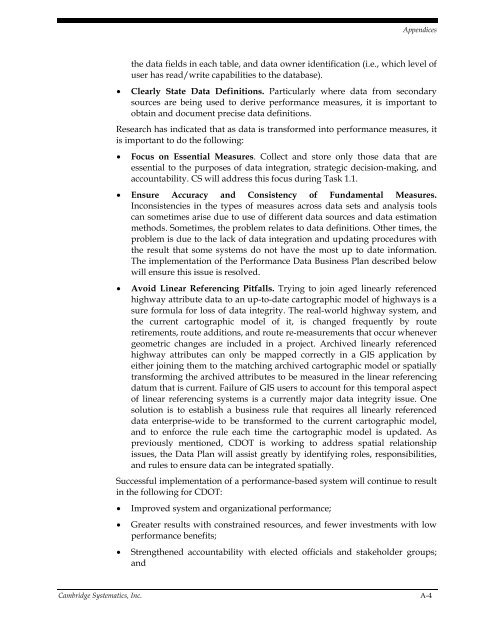CDOT Performance Data Business Plan - Cambridge Systematics
CDOT Performance Data Business Plan - Cambridge Systematics
CDOT Performance Data Business Plan - Cambridge Systematics
You also want an ePaper? Increase the reach of your titles
YUMPU automatically turns print PDFs into web optimized ePapers that Google loves.
Appendices<br />
<br />
the data fields in each table, and data owner identification (i.e., which level of<br />
user has read/write capabilities to the database).<br />
Clearly State <strong>Data</strong> Definitions. Particularly where data from secondary<br />
sources are being used to derive performance measures, it is important to<br />
obtain and document precise data definitions.<br />
Research has indicated that as data is transformed into performance measures, it<br />
is important to do the following:<br />
<br />
Focus on Essential Measures. Collect and store only those data that are<br />
essential to the purposes of data integration, strategic decision-making, and<br />
accountability. CS will address this focus during Task 1.1.<br />
Ensure Accuracy and Consistency of Fundamental Measures.<br />
Inconsistencies in the types of measures across data sets and analysis tools<br />
can sometimes arise due to use of different data sources and data estimation<br />
methods. Sometimes, the problem relates to data definitions. Other times, the<br />
problem is due to the lack of data integration and updating procedures with<br />
the result that some systems do not have the most up to date information.<br />
The implementation of the <strong>Performance</strong> <strong>Data</strong> <strong>Business</strong> <strong>Plan</strong> described below<br />
will ensure this issue is resolved.<br />
<br />
Avoid Linear Referencing Pitfalls. Trying to join aged linearly referenced<br />
highway attribute data to an up-to-date cartographic model of highways is a<br />
sure formula for loss of data integrity. The real-world highway system, and<br />
the current cartographic model of it, is changed frequently by route<br />
retirements, route additions, and route re-measurements that occur whenever<br />
geometric changes are included in a project. Archived linearly referenced<br />
highway attributes can only be mapped correctly in a GIS application by<br />
either joining them to the matching archived cartographic model or spatially<br />
transforming the archived attributes to be measured in the linear referencing<br />
datum that is current. Failure of GIS users to account for this temporal aspect<br />
of linear referencing systems is a currently major data integrity issue. One<br />
solution is to establish a business rule that requires all linearly referenced<br />
data enterprise-wide to be transformed to the current cartographic model,<br />
and to enforce the rule each time the cartographic model is updated. As<br />
previously mentioned, <strong>CDOT</strong> is working to address spatial relationship<br />
issues, the <strong>Data</strong> <strong>Plan</strong> will assist greatly by identifying roles, responsibilities,<br />
and rules to ensure data can be integrated spatially.<br />
Successful implementation of a performance-based system will continue to result<br />
in the following for <strong>CDOT</strong>:<br />
<br />
<br />
<br />
Improved system and organizational performance;<br />
Greater results with constrained resources, and fewer investments with low<br />
performance benefits;<br />
Strengthened accountability with elected officials and stakeholder groups;<br />
and<br />
<strong>Cambridge</strong> <strong>Systematics</strong>, Inc. A-4

















